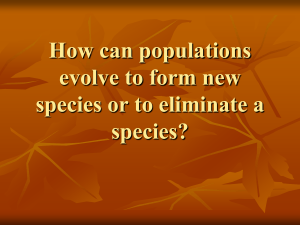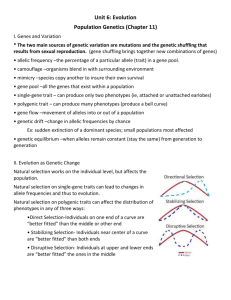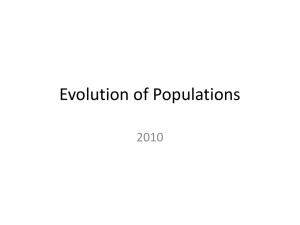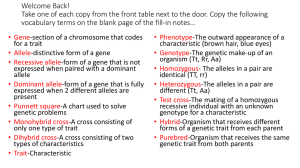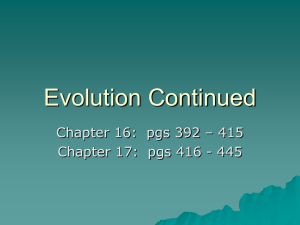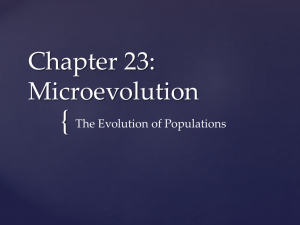Chapter 17: Evolution of Populations
advertisement
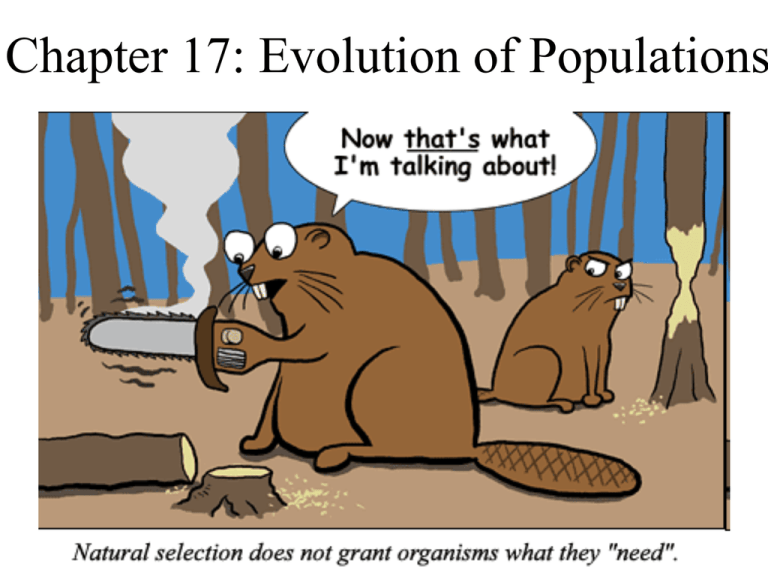
Chapter 17: Evolution of Populations 17.1 Genes and Variation Populations and Gene Pools • Population – a group of individuals of the same species that mate and produce offspring • Gene pool – all genes and the alleles for those genes present in a population • Allele frequency – the number of times an allele occurs in a gene pool compared to the total number of alleles in that pool for the same gene. 17.1 Genes and Variation Populations and Gene Pools • Take home message: Evolution, in genetic terms, involves a change in the frequency of alleles in a population over time. • Note: Although natural selection acts on individuals it is the population that evolves, not individuals 17.1 Genes and Variation Single-Gene and Polygenic Traits • Single-Gene Trait – Controlled by one gene that has two alleles – Two distinct phenotypes – Ex: bands or no bands on snails • Polygenic Trait – Controlled by more than one gene – Many possible genotypes and phenotypes – Ex: Human Height 17.2 Evolution as Genetic Change in Populations Natural selection on single gene traits Evolution does not act on genes. Instead it acts on phenotype frequencies by changing allele frequencies! Evolution = any change in the relative frequencies of alleles in a population’s gene pool Initial Population Generation 10 Generation 20 Generation 30 90% 80% 70% 40% 10% 20% 30% 60% Natural selection on polygenic traits • Natural selection can affect the relative fitness of phenotypes involving polygenic traits in any of 3 ways: 1. Stabilizing Selection -average form of a trait is favored. 2. Directional Selection -one extreme form of a trait is favored. 3. Disruptive Selection - either/both extremes of a trait are favored over an average form of a trait. Stabilizing selection Directional selection Disruptive selection 17.2 Evolution as Genetic Change in Populations Genetic Drift • Genetic Drift = random change in allele frequency • Acts on small populations • These chance occurrences can cause an allele to become more or less frequent in a population 17.2 Evolution as Genetic Change in Populations Genetic Bottlenecks • Genetic Bottleneck = a change in allele frequency following a dramatic reduction in the size of a population • Could result from disease, rapid climate or environmental change • Can reduce a populations genetic diversity 17.2 Evolution as Genetic Change in Populations Founder Effect • Founder Effect = when allele frequencies changes as a result of the migration of a small subgroup of a population • Creates a new gene pool that could be different from the parent population 17.3 The Process of Speciation • Species - group that can interbreed and produce fertile offspring. • Speciation – the formation of new species, occurs whenever reproductive isolation develops 17.3 The Process of Speciation Reproductive isolation develops by: • Behavioral Isolation • Geographic Isolation • Temporal Isolation Behavioral Isolation • Two populations are capable of interbreeding • Differences in mating rituals prevent interbreeding • Ex: Similar birds will not interbreed b/c of different mating songs Geographic Isolation • 2 populations are physically separated by barriers – Rivers – Mountains – Bodies of water Temporal Isolation • Two or more species reproduce at different times • Ex: One form of cicada emerges every 17 years, the other emerges every 13 years.
